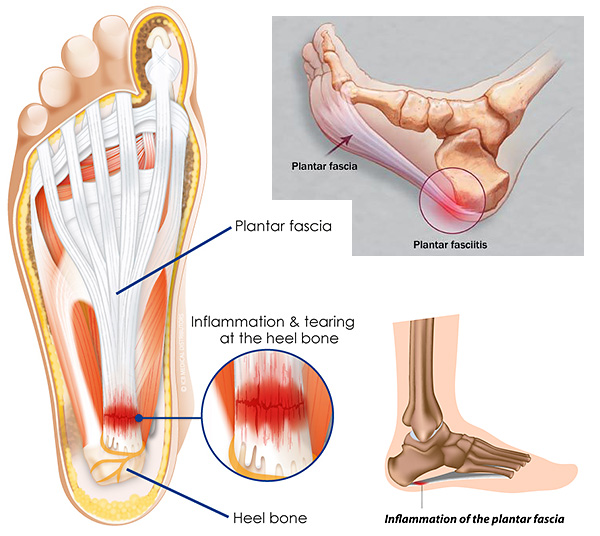Plantar Fasciitis Surgery
You might not be working out as much as usual while you're pregnant, but make time for stretching. Stretch your feet and calves throughout the day. Stretch along the wall or sit down and spread your legs and stretch that way. Arch your feet sitting on a birthing ball. My chiropractor also suggests freezing a bottle of water and then rolling that with your foot to help stretch the tight muscles causing the pain. In a recent study more than 80% of patients suffering from plantar fasciitis reported that increasing flexibility aided their recovery and over 25 per cent. thought that their stretching regimes were the best treatment they tried. Is there a difference between Plantar Fasciitis and heel spurs? While there is a difference between the two conditions, they are related. Plantar fasciitis is a condition where the thick tissue on the bottom or your foot becomes irritated and swollen. Plantar Fasciitis means inflammation of your plantar fascia. The plantar fascia is tissue that holds up the bones on the bottom of your foot. When you have this condition you usually feel pain in the bottom or your heel. This may be due to arch problems. When your plantar fascia pulls away from the heel, calcium deposits can form there. Plantar fasciitis can be caused by a tear, swelling or extreme tightness in the fascia. A variety of treatments are recommended and usually include some combination of rest and gently stretching to strengthen and increase flexibility in the fascia. Yoga, or any type of weight-bearing exercise, can cause added problems if the injury is severe. However, with milder symptoms or just a tight fascia, yoga can be part of a treatment plan and help prevent reoccurring bouts. You Might Also Like Poses To understand the terms ‘Pronation’ and ‘Supination’, firstly we need to look at the gait cycle – that is the way we walk, or our ‘walking pattern’. Orthotics can be obtained from a foot specialist (podiatrist). These are called custom orthotics and they usually quite hard. Nowadays there are softer orthotics on the market, which are made of EVA and which mold themselves to the wearer's foot shape because of body heat and body weight. These softer orthotics are pre-made and can be very effective in the treatment of Plantar Fasciitis. They are available without a prescription from pharmacies and specialty websites. Coblation surgery (aka Topaz procedure) has been used successfully in the treatment of recalcitrant plantar fasciitis. This procedure utilizes radiofrequency ablation and is a minimally invasive procedure. Plantar Fasciitis will cause many people to experience terrible heel pain in the morning, when they get out of bed and take their first steps. This pain is a result of tightening of the plantar fascia that happens during are asleep. Massaging and stretching the plantar fascia prior to getting up will help reduce heel pain. Whether you suffer from over-pronation like 70% of the population, or you have truly flat feet , in both cases your poor walking pattern may contribute to a range of different foot ailments. These can be prevented by wearing shoe inserts and orthotic insoles regularly. Plantar fasciitis occurs because of irritation to the thick ligamentous connective tissue that runs from the heel bone to the ball of the foot. This strong and tight tissue contributes to maintaining the arch of the foot. It is also one of the major transmitters of weight across the foot as you walk or run. Therefore, the stress placed on the this tissue is tremendous. Plantar Fasciitis is actually a form of irritation, something that can be easily treated. The irritation itself actually stems from the bottom of the heel. Those who strike hard on their heel will find that they suffer from Plantar Fasciitis
Orthotics can be obtained from a foot specialist (podiatrist). These are called custom orthotics and they usually quite hard. Nowadays there are softer orthotics on the market, which are made of EVA and which mold themselves to the wearer's foot shape because of body heat and body weight. These softer orthotics are pre-made and can be very effective in the treatment of Plantar Fasciitis. They are available without a prescription from pharmacies and specialty websites. Coblation surgery (aka Topaz procedure) has been used successfully in the treatment of recalcitrant plantar fasciitis. This procedure utilizes radiofrequency ablation and is a minimally invasive procedure. Plantar Fasciitis will cause many people to experience terrible heel pain in the morning, when they get out of bed and take their first steps. This pain is a result of tightening of the plantar fascia that happens during are asleep. Massaging and stretching the plantar fascia prior to getting up will help reduce heel pain. Whether you suffer from over-pronation like 70% of the population, or you have truly flat feet , in both cases your poor walking pattern may contribute to a range of different foot ailments. These can be prevented by wearing shoe inserts and orthotic insoles regularly. Plantar fasciitis occurs because of irritation to the thick ligamentous connective tissue that runs from the heel bone to the ball of the foot. This strong and tight tissue contributes to maintaining the arch of the foot. It is also one of the major transmitters of weight across the foot as you walk or run. Therefore, the stress placed on the this tissue is tremendous. Plantar Fasciitis is actually a form of irritation, something that can be easily treated. The irritation itself actually stems from the bottom of the heel. Those who strike hard on their heel will find that they suffer from Plantar Fasciitis